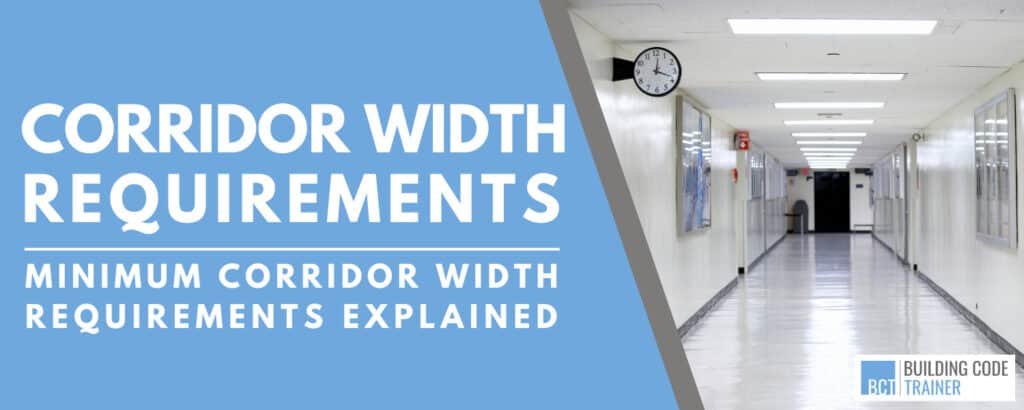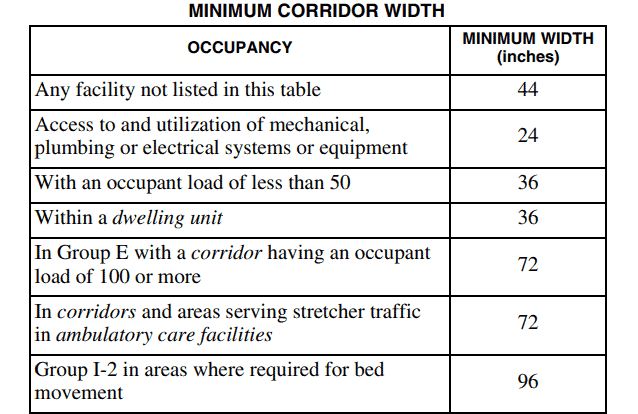Author : Building Code Trainer

When corridors are provided, Section 1020.3 of the 2021 International Building Code (IBC) establishes the minimum required width of corridors within buildings and structures subject to the IBC.
An important thing to note here from the beginning is not to confuse a hallway with a corridor. A hallway is used in residential structures subject to the International Residential Code. Unlike a corridor, a hallway is not as complicated to understand.
The purpose of a corridor enclosure is the provide protection to occupants who travel through it as they make their way to an exit. To ensure occupants travel safety through it, a corridor must be sized properly for the number of occupants it serves.
Before we get into the minimum width requirements of corridors, let us see how the IBC defines a corridor.
CORRIDOR – An enclosed exit access component that defines and provides a path of egress travel.
Chapter 10 of the International Building Code (IBC) provides minimum requirements for designing the Means of Egress system in all buildings and structures.
The primary purpose of this is to establish a method of protecting people in buildings from the presence of a fire. The means of egress system for a building or structure provides a way of travel for occupants to escape while avoiding a fire.
A Means of Egress system has 3 parts to it: (1) Exit Access, (2) Exit, (3) Exit Discharge.
Based on the definition of a corridor we can see that it serves as an egress access component making it part of the means of egress system within the building. This is why the code regulates it.
Now going back to the corridor section in 1020.3, the code establishes a minimum size based on the required occupant capacity (total occupant load) that the corridor serves.
Therefore let us see what code Section 1020.3 says.
Minimum Corridor Width and Capacity
The required capacity of corridors shall be determined as specified in Section 1005.1, but the minimum width shall be not less than that specified in Table 1020.3.
There are two thing to note in this code section. The first is the required capacity of the corridor and the second is the minimum width.
This might be confusing at first but lets walk through this to better understand the code section.
The required capacity of a corridor is based on the total occupant load served by the corridor. This is determined by Section 1005.1. This is the first place you must look to determine the required width of the corridor. Then when you know what the required width of the corridor must be, go to Table 1020.3 to verify the minimum width required.
After you have done this, compare the two numbers and go with the most restrictive. This means that the actual width of the corridor is to be the larger of the two widths.
If the required width calculates to be less than the minimum width, then go with the minimum width. However if the required width calculates out to be greater than the minimum width, then the calculated required width becomes the minimum width.
This will be better understood when we do an example.
First lets go to Section 1005.1 to learn how to calculate the required width.
How to Calculate the Required Width of a Corridor?
Section 1005.1 outlines how to calculate portions of a means of egress system. It specifies that the required capacity is to be based on the occupant load. The two main egress components that are specified here are ‘stairways‘ and ‘other egress components’.
Other egress components can be considered features such as corridors, doors, ramps, aisles, etc…
Therefore we can use this section to size a corridor. Section 1005.3.2 reads as follows:
The capacity, in inches, of means of egress components other than stairways shall be calculated by multiplying the occupant load served by such component by a means of egress capacity factor of 0.2 inch per occupant.
It is important to note here that there are exceptions to this section that can reduce the required width, such as when a building is fully fire sprinklered.
You can read more about what these exceptions are in Section 1005.3.2.
For simplicity, let us take a look at this section as it is written for now to calculate the required capacity of a corridor.
Example Problem – Calculate Required Width
If a corridor serves 200 occupants, the code section above says that the egress capacity of the corridor is to be 0.2 inch per occupant.
In this example 200 x 0.2 = 40 inches
The required width of the corridor must be at least 40 inches.
Now that we know the required width, let us see what the minimum width of the corridor must be. To do this we will have to go back to Section 1020.3.
How to Determine the Minimum Width of a Corridor?
Section 1020.3 states that the minimum width of a corridor shall not be less than that specified in Table 1020.3.

Table 1020.3 is split into 2 columns. One is occupancy and the other is the minimum width. Lets refer back to the example we had prior and assume the corridor is located in a facility that is not listed in this table.
The table requires a minimum width of 44 inches for that occupancy type. It is best to look through all other options in the table as well to make sure you select the correct occupancy.
Now if the prior example required a width of 40 inches, and this Table specifies a minimum width of 44 inches, then the corridor shall have a width of no less than 44 inches since this is the larger (most restrictive) number of the two.
It is important to note that some designers will design a corridor width to be much larger than what the code requires, and this is fine, the code just establishes the minimum required width to ensure a proper level of safety is being provided to the occupants served by the corridor.
Lets look at another example.
Example Problem – Calculate Required Width
A corridor within a Group E building serves 400 occupants.
Code section 1005.3.2 says that the egress capacity of a corridor is to be 0.2 inch per occupant.
In this example 400 x 0.2 = 80 inches
Now let us see what the minimum width of the corridor must be per Table 1020.2.
Per Table 1020.3 a Group E corridor having an occupant load of 100 or more must have a minimum width of 72 inches.
Since the required width in this example is greater than the minimum width required per the table, then the larger value of 80 inches becomes the minimum required width of the corridor.
Fun Tip: To learn about Corridor Fire Rating Requirements, be sure to check out this POST.
Final Thoughts
Again it is important to note that there are sometimes exceptions that might allow a reduction to the minimum width required based on certain scenarios therefore is it always important to read a code section entirely before you begin to apply it.
For more information regarding corridor requirements, be sure to check out Section 1020 of the 2021 International Building Code.
Related Articles to Read:
- How to Calculate Occupant Load | Easily Explained with Examples
- Corridor Fire Rating Requirements | Explained!
- Commercial Stair Codes: EXPLAINED
About the Author

Building Code Trainer
AuthorThis site is run and maintained by a Certified Building Official, Plans Examiner, and Inspector. With a Bachelors of Science Degree in Construction Engineering along with holding multiple ICC certifications, the Author of this site has over 15 years of experience within the construction industry.
